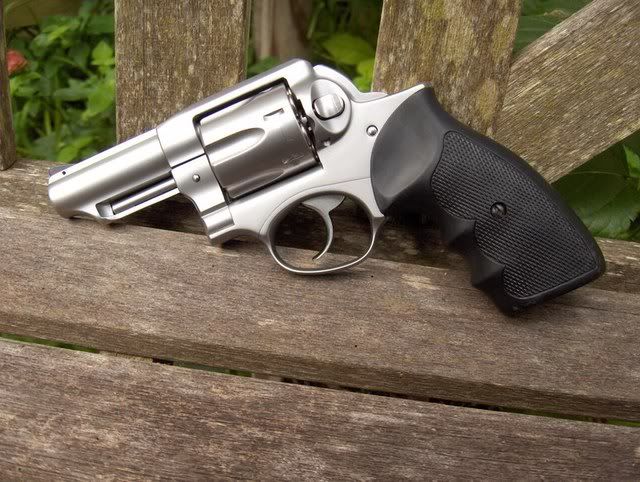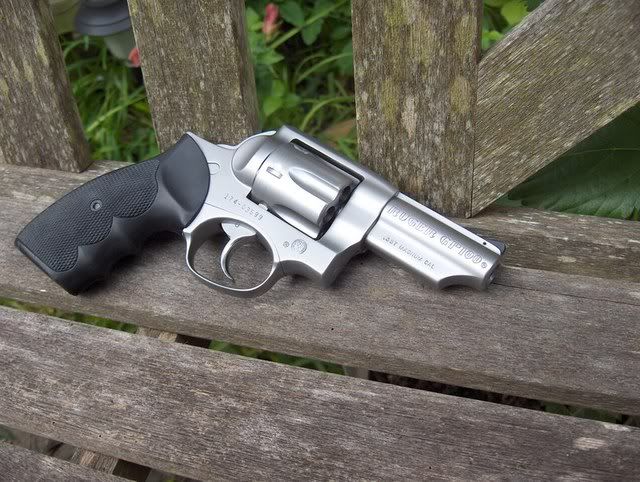2000 Shots Later: Ruger GP100 w/3" Bbl...
Posted: Thu May 10, 2007 12:26 pm
Hello. Back in 2003, I purchased a NIB Ruger GP100 w/3" bbl and the "short shroud" at a nice price. I'd been trying to find a like-new S&W Model 681 to replace the excellent one that I'd owned a few years before and foolishly traded away.
I was surprised at the nice double-action pull on the Ruger but a tad disappointed in the single-action pull; it just wasn't as nice as on the typical S&W.
At the range I was definitely not disappointed in the revolver's performance. It was utterly reliable and a peach to shoot with any of the 357 loads tried. For those who might be interested, results and observations are here:
http://www.hipowersandhandguns.com/Rang ... 0GP100.htm
Since that original report, I've shot approximately 2000 .357 Magnum loads, factory and handloaded, through this revolver. Certainly, this is really not a "long-term" situation, but I think it represents enough of one to suggest that the GP100 is most capable of handling more than enough magnum rounds for the most shooters in a lifetime.
The DA pull has gotten better with use and frankly, is as smooth and light as any of my S&W revolvers. The single-action is still not as light and crisp as those on the S&W's, but it is imminently useable.
The factory load I shoot most often in this gun is Winchester's 145-gr. STHP. An "old technology" bullet is used in it to be sure, but it has "worked" nicely for me on critters and groups well in most revolvers I've shot it through. This GP100 is no exception. Today, I used a handload consisting of cast 158-gr. SWC's over 7.0-grains Unique powder. One can certainly go hotter but this one's worked nicely for me and seems close enough to the Winchester STHP load to allow for more economical shooting as a substitute for this usual "carry round." Based on ten-shot strings fired 10' from the chronograph screens, the Winchester 145-gr. STHP averages 1197 ft/sec with a standard deviation of 17. The CSWC handload does 1154 ft/sec with the same SD. I also used a Rainier 158-gr. PFP over the same powder charge just to see what it would do, but didn't chronograph it...yet.
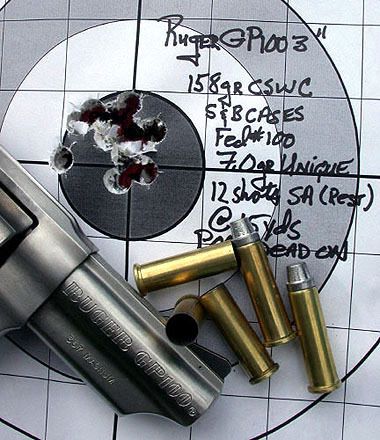
Seated and with wrists braced, this group was shot slow-fire and in single-action using the SWC handload. POA was the center of the bullseye. It groups satisfactorily albeit a tad high at 25 & 50 yards, at least for my eyes.
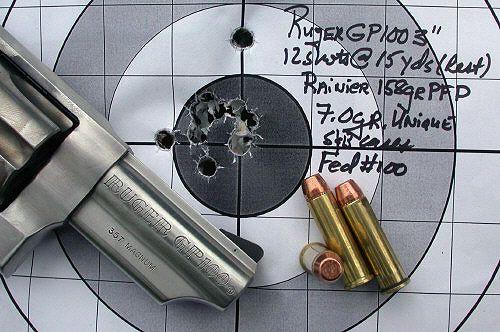
I repeated the process for the Rainier handload but fired in double-action. To me, the groups are equivalent. This was not really much of a surprise but a reaffirmation that some precise work can be done double-action. Back in my police PPC days, like many other shooters, I opted to shoot all of the stages, including 50 yards in double-action. To do much good at it, the action must be smooth. We were all shooting either S&W or Colt revolvers then, but this GP100's slick DA lent itself nicely to double-action shooting.
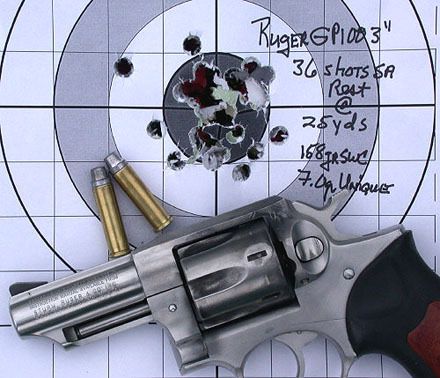
At 25 yards, I did the single-action thing again using a 6 O' Clock hold at the bottom of the bullseye. This is close enough for my shooting "needs" and I was more than happy with the results.

Moving to 10 yards, I fired several "Failure to Stop" drills from a standing position and using a two-hand hold. I didn't have a timer but fired the torso shots as quickly as I could obtain a "flash sight picture." A few shots were a tad farther out than I would have preferred but so the chips fell. The head shots were a bit slower. I would estimate that the torso shots were fired at about 2 shots per second and the head shots at half that. A certain revolver superstar with the initials "JM" has nothing to fear from me!"
After that, I shot falling plates a few times from 10 and 15 yards with the SWC load and shot at a "metal man" from 50 and about 65 yards standing, using both single and double-action. I was surprised that there were more hits than misses; there is no doubt that the misses were due to operator error.
Again, not really all that many shots have been fired through this revolver to constitute true long-term results, but so far I believe that the gun is a very good buy and long lasting. To my eye, it remains a cut below those of the classic S&W but on the range or field or in the "dark place" that doesn't count for much in my opinion.
I cannot say that it would be true for all Rugers, but this one has proven itself to be capable of extremely smooth double-action use as it came from the box, though its single-action doesn't match the Smith & Wesson's, at least not on my gun.
I like this revolver very much, more than when I initially purchased it and plan to continue using it both at the range and as a carry gun in the woods. It is also a "house gun" and one that is always loaded.

The crane-to-frame fit has remained constant with no "slop" and the revolver's cylinder remains timed nicely. It locks soundly before the hammer drops. The gun has never bound up when firing...at least to 300 shots. It has not been fired more than that between cleanings. Leading has been very minor and easily removed, indicating a smoothly bored barrel.
This revolver is stock; no changes whatsoever have been made with it. While this is entirely subjective to the individual shooter, I've found the factory stocks to be comfortable and plan on making no changes to this handgun.

In my opinion, the GP100 is a very viable choice for folks wanting a .357 Magnum that should be both long-lasting and easy to handle. It is neither the smallest nor the largest example and certainly not the lightest, but it is not hard to tote and its weight handles the magnum's recoil nicely.
This one remains a keeper.
Best.
I was surprised at the nice double-action pull on the Ruger but a tad disappointed in the single-action pull; it just wasn't as nice as on the typical S&W.
At the range I was definitely not disappointed in the revolver's performance. It was utterly reliable and a peach to shoot with any of the 357 loads tried. For those who might be interested, results and observations are here:
http://www.hipowersandhandguns.com/Rang ... 0GP100.htm
Since that original report, I've shot approximately 2000 .357 Magnum loads, factory and handloaded, through this revolver. Certainly, this is really not a "long-term" situation, but I think it represents enough of one to suggest that the GP100 is most capable of handling more than enough magnum rounds for the most shooters in a lifetime.
The DA pull has gotten better with use and frankly, is as smooth and light as any of my S&W revolvers. The single-action is still not as light and crisp as those on the S&W's, but it is imminently useable.
The factory load I shoot most often in this gun is Winchester's 145-gr. STHP. An "old technology" bullet is used in it to be sure, but it has "worked" nicely for me on critters and groups well in most revolvers I've shot it through. This GP100 is no exception. Today, I used a handload consisting of cast 158-gr. SWC's over 7.0-grains Unique powder. One can certainly go hotter but this one's worked nicely for me and seems close enough to the Winchester STHP load to allow for more economical shooting as a substitute for this usual "carry round." Based on ten-shot strings fired 10' from the chronograph screens, the Winchester 145-gr. STHP averages 1197 ft/sec with a standard deviation of 17. The CSWC handload does 1154 ft/sec with the same SD. I also used a Rainier 158-gr. PFP over the same powder charge just to see what it would do, but didn't chronograph it...yet.

Seated and with wrists braced, this group was shot slow-fire and in single-action using the SWC handload. POA was the center of the bullseye. It groups satisfactorily albeit a tad high at 25 & 50 yards, at least for my eyes.

I repeated the process for the Rainier handload but fired in double-action. To me, the groups are equivalent. This was not really much of a surprise but a reaffirmation that some precise work can be done double-action. Back in my police PPC days, like many other shooters, I opted to shoot all of the stages, including 50 yards in double-action. To do much good at it, the action must be smooth. We were all shooting either S&W or Colt revolvers then, but this GP100's slick DA lent itself nicely to double-action shooting.

At 25 yards, I did the single-action thing again using a 6 O' Clock hold at the bottom of the bullseye. This is close enough for my shooting "needs" and I was more than happy with the results.

Moving to 10 yards, I fired several "Failure to Stop" drills from a standing position and using a two-hand hold. I didn't have a timer but fired the torso shots as quickly as I could obtain a "flash sight picture." A few shots were a tad farther out than I would have preferred but so the chips fell. The head shots were a bit slower. I would estimate that the torso shots were fired at about 2 shots per second and the head shots at half that. A certain revolver superstar with the initials "JM" has nothing to fear from me!"
After that, I shot falling plates a few times from 10 and 15 yards with the SWC load and shot at a "metal man" from 50 and about 65 yards standing, using both single and double-action. I was surprised that there were more hits than misses; there is no doubt that the misses were due to operator error.
Again, not really all that many shots have been fired through this revolver to constitute true long-term results, but so far I believe that the gun is a very good buy and long lasting. To my eye, it remains a cut below those of the classic S&W but on the range or field or in the "dark place" that doesn't count for much in my opinion.
I cannot say that it would be true for all Rugers, but this one has proven itself to be capable of extremely smooth double-action use as it came from the box, though its single-action doesn't match the Smith & Wesson's, at least not on my gun.
I like this revolver very much, more than when I initially purchased it and plan to continue using it both at the range and as a carry gun in the woods. It is also a "house gun" and one that is always loaded.

The crane-to-frame fit has remained constant with no "slop" and the revolver's cylinder remains timed nicely. It locks soundly before the hammer drops. The gun has never bound up when firing...at least to 300 shots. It has not been fired more than that between cleanings. Leading has been very minor and easily removed, indicating a smoothly bored barrel.
This revolver is stock; no changes whatsoever have been made with it. While this is entirely subjective to the individual shooter, I've found the factory stocks to be comfortable and plan on making no changes to this handgun.

In my opinion, the GP100 is a very viable choice for folks wanting a .357 Magnum that should be both long-lasting and easy to handle. It is neither the smallest nor the largest example and certainly not the lightest, but it is not hard to tote and its weight handles the magnum's recoil nicely.
This one remains a keeper.
Best.
